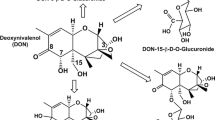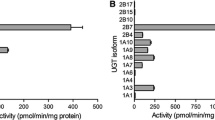Abstract
Alternariol (AOH) and alternariol-9-methyl ether (AME) are major toxins produced by fungi of the genus Alternaria and are frequently found in various food items. Because AOH has three hydroxyl groups and AME two, the formation of various glucuronides must be expected. When AOH was incubated with hepatic and intestinal microsomes from rats, pigs and humans in the presence of uridine diphosphate glucuronic acid, two glucuronides were detected and tentatively identified as AOH-3-O-glucuronide and AOH-9-O-glucuronide. Under the same conditions, AME yielded predominantly AME-3-O-glucuronide and only small amounts of AME-7-O-glucuronide. The activities of all microsomes for the glucuronidation of AOH and AME were in the same range. Nine out of ten recombinant human UDP-glucuronosyltransferases (UGTs) were able to glucuronidate AOH, and eight out of ten UGTs had activity for AME. These data suggest that AOH and AME are readily glucuronidated in hepatic and extrahepatic tissues, implying that glucuronidation constitutes a major metabolic pathway in the disposition of these mycotoxins.




Similar content being viewed by others
References
Basu NK, Ciotti M, Hwang MS, Kole L, Mitra PS, Cho JW, Owens IS (2004) Differential and special properties of the major human UGT1-encoded gastrointestinal UDP-glucuronosyltransferases enhance potential to control chemical uptake. J Biol Chem 279:1429–1441
Bradford MM (1976) A rapid and sensitive method for the quantitation of microgram quantities of protein utilizing the principle of protein-dye binding. Anal Biochem 72:248–254
Brugger EM, Wagner J, Schumacher DM, Koch K, Podlech J, Metzler M, Lehmann L (2006) Mutagenicity of the mycotoxin alternariol in cultured mammalian cells. Toxicol Lett 164:221–230
Buckley DB, Klaassen CD (2007) Tissue- and gender-specific mRNA expression of UDP-glucuronosyltransferases (UGTs) in mice. Drug Metab Dispos 35:121–127
Chelkowski J, Visconti A (eds) (1992) Alternaria. Biology, plant diseases and metabolites. Elsevier, Amsterdam
Fehr M, Pahlke G, Fritz J, Christensen MO, Boege F, Altemöller M, Podlech J, Marko D (2008) Alternariol acts as a topoisomerase poison, preferentially affecting the II alpha isoform. Mol Nutr Food Res (in press)
Fisher MB, Campanale K, Ackermann BL, Vandenbranden M, Wrighton SA (2000) In vitro glucuronidation using human liver microsomes and the pore-forming peptide alamethicin. Drug Metab Dispos 28:560–566
Harvey DJ (1981) The mass spectra of the trimethylsilyl derivatives of ginger constituents. Biomed Mass Spectrom 8:546–552
Hoehle SI, Pfeiffer E, Metzler M (2007) Glucuronidation of curcuminoids by human microsomal and recombinant UDP-glucuronosyltransferases. Mol Nutr Food Res 51:932–938
King CD, Rios GR, Green MD, Tephly TR (2000) UDP-glucuronosyltransferases. Curr Drug Metab 1:143–161
Koch K, Podlech J, Pfeiffer E, Metzler M (2005) Total synthesis of alternariol. J Org Chem 70:3275–3276
Kulling SE, Honig DM, Metzler M (2001) Oxidative metabolism of the soy isoflavones daidzein and genistein in humans in vitro and in vivo. J Agric Food Chem 49:3024–3033
Lehmann L, Wagner J, Metzler M (2006) Estrogenic and clastogenic potential of the mycotoxin alternariol in cultured mammalian cells. Food Chem Toxicol 44:398–408
Lilienblum W, Walli AK, Bock KW (1982) Differential induction of rat liver microsomal UDP-glucuronosyltransferase activities by various inducing agents. Biochem Pharmacol 31:907–913
Liu GT, Qian YZ, Zhang P, Dong WH, Qi YM, Guo HT (1992) Etiological role of Alternaria alternata in human esophageal cancer. Chinese Med J 105:394–400
McGurk KA, Brierley CH, Burchell B (1998) Drug glucuronidation by human renal UDP-glucuronosyltransferases. Biochem Pharmacol 55:1005–1012
Pfeiffer E, Heuschmid FF, Kranz S, Metzler M (2006) Microsomal hydroxylation and glucuronidation of [6]-gingerol. J Agric Food Chem 54:8769–8774
Pfeiffer E, Eschbach S, Metzler M (2007a) Alternaria toxins: DNA strand-breaking activity in mammalian cells in vitro. Mycotoxin Res 23:152–157
Pfeiffer E, Schebb NH, Podlech J, Metzler M (2007b) Novel oxidative in vitro metabolites of the mycotoxins alternariol and alternariol methyl ether. Mol Nutr Food Res 51:307–316
Pfeiffer E, Burkhardt B, Metzler M (2008a) Oxidative metabolism of the mycotoxin alternariol in precision-cut rat liver slices. In: Abstracts of the 29th Annual Meeting of the American College of Toxicology, Tucson, USA, November 9–12, 2008 p. 79
Pfeiffer E, Herrmann C, Altemöller M, Podlech J, Metzler M (2008b) Oxidative in vitro metabolism of the Alternaria toxins altenuene and isoaltenuene. Mol Nutr Food Res (in press)
Scott PM (2001) Analysis of agricultural commodities and foods for Alternaria mycotoxins. J AOAC Int 84:1809–1817
Scott PM, Lawrence GA, Lau BPY (2006) Analysis of wines, grape juices and cranberry juices for Alternaria toxins. Mycotoxin Res 22:142–147
Strassburg CP, Nguyen N, Manns MP, Tukey RH (1999a) UDP-glucuronosyltransferase activity in human liver and colon. Gastroenterology 116:149–160
Strassburg CP, Strassburg A, Nguyen N, Li Q, Manns MP, Tukey RH (1999b) Regulation and function of family 1 and family 2 UDP-glucuronosyltransferase genes (UGT1A, UGT2B) in human oesophagus. Biochem J 338:489–498
Tukey RH, Strassburg CP (2000) Human UDP-glucuronosyltransferases: metabolism, expression, and disease. Annu Rev Pharmacol Toxicol 40:581–616
Turgeon D, Carrier JS, Levesque E, Hum DW, Belanger A (2001) Relative enzymatic activity, protein stability, and tissue distribution of human steroid-metabolizing UGT2Bsubfamily members. Endocrinology 142:778–787
Acknowledgements
Financial support for this work was provided by the state of Baden-Württemberg (research program “Mycotoxins” as part of the research initiative “Food and Health”).
Author information
Authors and Affiliations
Corresponding author
Rights and permissions
About this article
Cite this article
Pfeiffer, E., Schmit, C., Burkhardt, B. et al. Glucuronidation of the mycotoxins alternariol and alternariol-9-methyl ether in vitro: chemical structures of glucuronides and activities of human UDP-glucuronosyltransferase isoforms. Mycotox Res 25, 3–10 (2009). https://doi.org/10.1007/s12550-008-0001-z
Received:
Revised:
Accepted:
Published:
Issue Date:
DOI: https://doi.org/10.1007/s12550-008-0001-z




